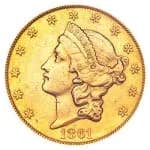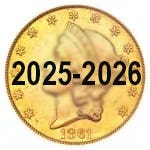Copper reaching historic highs
With copper at historic highs of $2.24 a pound, the circulating inventory of billions of mostly copper one-cent pieces produced in the 20th century is in jeopardy of being melted for its metal content (Believe it or not, some are still being used, others ended up in the proverbial sock drawer).
Any old pre-1983 small cent now has at least 1.45 cents? worth of copper in it. Surprised?
With copper at historic highs of $2.24 a pound, the circulating inventory of billions of mostly copper one-cent pieces produced in the 20th century is in jeopardy of being melted for its metal content (Believe it or not, some are still being used, others ended up in the proverbial sock drawer).
Current cents made since 1982 are made of zinc coated with copper and are virtually immune from similar copper cost factors.
It takes 154 cents to yield a copper pound, which is measured in avoirdupois rather than the troy system used for precious metals. There is also nearly three-quarters of an ounce of zinc as a bonus.
When will it become economic for these coins to be melted? Perhaps not yet, but it will bear watching.
The last time something comparable happened was in 1973 and that resulted in a legislative initiative of the U.S. Mint to authorize an aluminum cent. The idea for that ultimately fizzled when the price of copper retreated below the Rubicon level that would have encouraged melting on a widespread scale.
Right now, with a copper coating and a zinc core, the Mint makes a modest profit of .0003 cents on each cent coin that it produces in the form of seigniorage, the difference between production cost and face value. In the course of the year, about $4 million in profit is made. If coins were still made of the full measure of copper, the Mint would produce them at a loss of about $30 million annually.
From 1874 to 1958, production of small cents totaled more than 27 billion coins. Add to that, more than 158 billion cents that were produced in the Lincoln Memorial cent series (1959-1982) at all three mints, Philadelphia, Denver and San Francisco, and you begin to take the measure of the sheer numbers of coins.
Nickels, which contain 3.75 grams of copper apiece, are also sensitive to the price changes of copper, but the price of copper would have to rise above $5 a pound to threaten the denomination with melting. A more serious issue is seigniorage, which has been steadily dropping for the Mint.
The 2002 Mint report shows that Mint production cost for the one cent piece is a solid $0.0089 cents apiece, or a net profit to the government of 11/100ths of a cent. The sum is a minor one and the profit is small ? but it is still in the millions of dollars, enough to sustain the coin.
Profits and losses for the period ending Sept. 30, 2002, show that the cent brought in $75.2 million in revenue (on 7.5 billion coins produced), cost of goods sold (including metal) of $63.7 million, less overhead expenses of $2.7 million for a net profit of $8.8 million ? more than the $3.4 million profit made from the half dollar.
Currently, there is no prohibition against melting minor coins of the U.S., such as a cents, for their metal content.
For coin collectors, the silver lining lies in the rising price of metal, which will inevitably lead to fewer coins available ? and greater value for those that survive.



